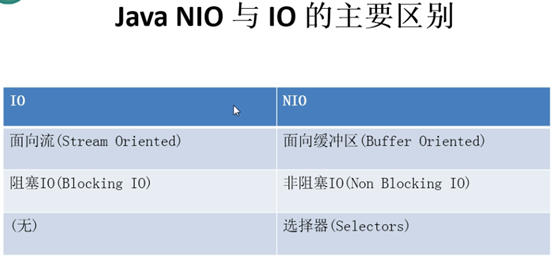
流是单向的 缓冲区是双向的
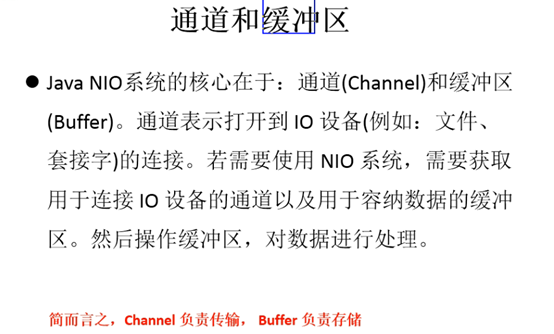



例子1:
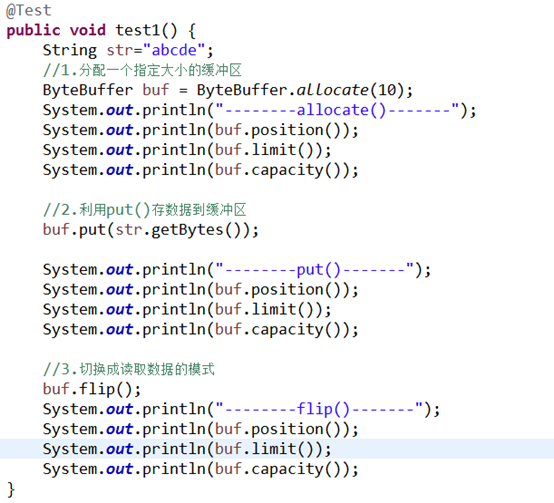
结果:
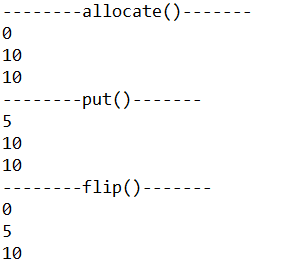
图例:
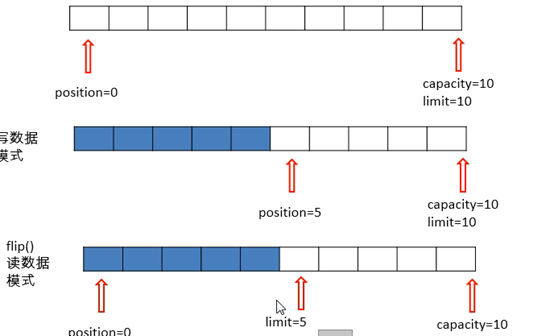
get():读取缓冲区中的数据
rewind():可重复读
clear():清空缓冲区,但是缓冲区的数据依然存在,但是出于被遗忘状态(指针被 拨回)



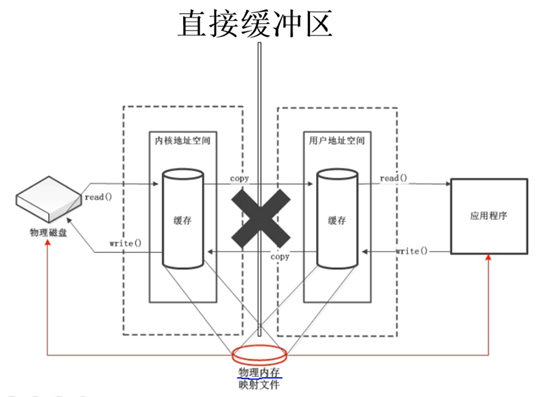


例子2:
/* * 一、通道(Channel):用于源节点与目标节点的连接。在 Java NIO 中负责缓冲区中数据的传输。Channel 本身不存储数据,因此需要配合缓冲区进行传输。 * * 二、通道的主要实现类 * java.nio.channels.Channel 接口: * |--FileChannel * |--SocketChannel * |--ServerSocketChannel * |--DatagramChannel * * 三、获取通道 * 1. Java 针对支持通道的类提供了 getChannel() 方法 * 本地 IO: * FileInputStream/FileOutputStream * RandomAccessFile * * 网络IO: * Socket * ServerSocket * DatagramSocket * * 2. 在 JDK 1.7 中的 NIO.2 针对各个通道提供了静态方法 open() * 3. 在 JDK 1.7 中的 NIO.2 的 Files 工具类的 newByteChannel() * * 四、通道之间的数据传输 * transferFrom() * transferTo() * * 五、分散(Scatter)与聚集(Gather) * 分散读取(Scattering Reads):将通道中的数据分散到多个缓冲区中 * 聚集写入(Gathering Writes):将多个缓冲区中的数据聚集到通道中 * * 六、字符集:Charset * 编码:字符串 -> 字节数组 * 解码:字节数组 -> 字符串 * */ public class TestChannel { //字符集 @Test public void test6() throws IOException{ Charset cs1 = Charset.forName("GBK"); //获取编码器 CharsetEncoder ce = cs1.newEncoder(); //获取解码器 CharsetDecoder cd = cs1.newDecoder(); CharBuffer cBuf = CharBuffer.allocate(1024); cBuf.put("威武!"); cBuf.flip(); //编码 ByteBuffer bBuf = ce.encode(cBuf); for (int i = 0; i < 12; i++) { System.out.println(bBuf.get()); } //解码 bBuf.flip(); CharBuffer cBuf2 = cd.decode(bBuf); System.out.println(cBuf2.toString()); System.out.println("------------------------------------------------------"); Charset cs2 = Charset.forName("GBK"); bBuf.flip(); CharBuffer cBuf3 = cs2.decode(bBuf); System.out.println(cBuf3.toString()); } @Test public void test5(){ Map<String, Charset> map = Charset.availableCharsets(); Set<Entry<String, Charset>> set = map.entrySet(); for (Entry<String, Charset> entry : set) { System.out.println(entry.getKey() + "=" + entry.getValue()); } } //分散和聚集 @Test public void test4() throws IOException{ RandomAccessFile raf1 = new RandomAccessFile("1.txt", "rw"); //1. 获取通道 FileChannel channel1 = raf1.getChannel(); //2. 分配指定大小的缓冲区 ByteBuffer buf1 = ByteBuffer.allocate(100); ByteBuffer buf2 = ByteBuffer.allocate(1024); //3. 分散读取 ByteBuffer[] bufs = {buf1, buf2}; channel1.read(bufs); for (ByteBuffer byteBuffer : bufs) { byteBuffer.flip(); } System.out.println(new String(bufs[0].array(), 0, bufs[0].limit())); System.out.println("-----------------"); System.out.println(new String(bufs[1].array(), 0, bufs[1].limit())); //4. 聚集写入 RandomAccessFile raf2 = new RandomAccessFile("2.txt", "rw"); FileChannel channel2 = raf2.getChannel(); channel2.write(bufs); } //通道之间的数据传输(直接缓冲区) @Test public void test3() throws IOException{ FileChannel inChannel = FileChannel.open(Paths.get("d:/1.mkv"), StandardOpenOption.READ); FileChannel outChannel = FileChannel.open(Paths.get("d:/2.mkv"), StandardOpenOption.WRITE, StandardOpenOption.READ, StandardOpenOption.CREATE); // inChannel.transferTo(0, inChannel.size(), outChannel); outChannel.transferFrom(inChannel, 0, inChannel.size()); inChannel.close(); outChannel.close(); } //使用直接缓冲区完成文件的复制(内存映射文件) @Test public void test2() throws IOException{//2127-1902-1777 long start = System.currentTimeMillis(); FileChannel inChannel = FileChannel.open(Paths.get("d:/1.mkv"), StandardOpenOption.READ); FileChannel outChannel = FileChannel.open(Paths.get("d:/2.mkv"), StandardOpenOption.WRITE, StandardOpenOption.READ, StandardOpenOption.CREATE); //内存映射文件 MappedByteBuffer inMappedBuf = inChannel.map(MapMode.READ_ONLY, 0, inChannel.size()); MappedByteBuffer outMappedBuf = outChannel.map(MapMode.READ_WRITE, 0, inChannel.size()); //直接对缓冲区进行数据的读写操作 byte[] dst = new byte[inMappedBuf.limit()]; inMappedBuf.get(dst); outMappedBuf.put(dst); inChannel.close(); outChannel.close(); long end = System.currentTimeMillis(); System.out.println("耗费时间为:" + (end - start)); } //利用通道完成文件的复制(非直接缓冲区) @Test public void test1(){//10874-10953 long start = System.currentTimeMillis(); FileInputStream fis = null; FileOutputStream fos = null; //①获取通道 FileChannel inChannel = null; FileChannel outChannel = null; try { fis = new FileInputStream("d:/1.mkv"); fos = new FileOutputStream("d:/2.mkv"); inChannel = fis.getChannel(); outChannel = fos.getChannel(); //②分配指定大小的缓冲区 ByteBuffer buf = ByteBuffer.allocate(1024); //③将通道中的数据存入缓冲区中 while(inChannel.read(buf) != -1){ buf.flip(); //切换读取数据的模式 //④将缓冲区中的数据写入通道中 outChannel.write(buf); buf.clear(); //清空缓冲区 } } catch (IOException e) { e.printStackTrace(); } finally { if(outChannel != null){ try { outChannel.close(); } catch (IOException e) { e.printStackTrace(); } } if(inChannel != null){ try { inChannel.close(); } catch (IOException e) { e.printStackTrace(); } } if(fos != null){ try { fos.close(); } catch (IOException e) { e.printStackTrace(); } } if(fis != null){ try { fis.close(); } catch (IOException e) { e.printStackTrace(); } } } long end = System.currentTimeMillis(); System.out.println("耗费时间为:" + (end - start)); } }
阻塞式:


选择器用来监控IO状态
阻塞式例子:
/* * 一、使用 NIO 完成网络通信的三个核心: * * 1. 通道(Channel):负责连接 * * java.nio.channels.Channel 接口: * |--SelectableChannel * |--SocketChannel * |--ServerSocketChannel * |--DatagramChannel * * |--Pipe.SinkChannel * |--Pipe.SourceChannel * * 2. 缓冲区(Buffer):负责数据的存取 * * 3. 选择器(Selector):是 SelectableChannel 的多路复用器。用于监控 SelectableChannel 的 IO 状况 * */ public class TestBlockingNIO { //客户端 @Test public void client() throws IOException{ //1. 获取通道 SocketChannel sChannel = SocketChannel.open(new InetSocketAddress("127.0.0.1", 9898)); FileChannel inChannel = FileChannel.open(Paths.get("1.jpg"), StandardOpenOption.READ); //2. 分配指定大小的缓冲区 ByteBuffer buf = ByteBuffer.allocate(1024); //3. 读取本地文件,并发送到服务端 while(inChannel.read(buf) != -1){ buf.flip(); sChannel.write(buf); buf.clear(); } //4. 关闭通道 inChannel.close(); sChannel.close(); } //服务端 @Test public void server() throws IOException{ //1. 获取通道 ServerSocketChannel ssChannel = ServerSocketChannel.open(); FileChannel outChannel = FileChannel.open(Paths.get("2.jpg"), StandardOpenOption.WRITE, StandardOpenOption.CREATE); //2. 绑定连接 ssChannel.bind(new InetSocketAddress(9898)); //3. 获取客户端连接的通道 SocketChannel sChannel = ssChannel.accept(); //4. 分配指定大小的缓冲区 ByteBuffer buf = ByteBuffer.allocate(1024); //5. 接收客户端的数据,并保存到本地 while(sChannel.read(buf) != -1){ buf.flip(); outChannel.write(buf); buf.clear(); } //6. 关闭通道 sChannel.close(); outChannel.close(); ssChannel.close(); } } 例子: public class TestBlockingNIO2 { //客户端 @Test public void client() throws IOException{ SocketChannel sChannel = SocketChannel.open(new InetSocketAddress("127.0.0.1", 9898)); FileChannel inChannel = FileChannel.open(Paths.get("1.jpg"), StandardOpenOption.READ); ByteBuffer buf = ByteBuffer.allocate(1024); while(inChannel.read(buf) != -1){ buf.flip(); sChannel.write(buf); buf.clear(); } sChannel.shutdownOutput(); //接收服务端的反馈 int len = 0; while((len = sChannel.read(buf)) != -1){ buf.flip(); System.out.println(new String(buf.array(), 0, len)); buf.clear(); } inChannel.close(); sChannel.close(); } //服务端 @Test public void server() throws IOException{ ServerSocketChannel ssChannel = ServerSocketChannel.open(); FileChannel outChannel = FileChannel.open(Paths.get("2.jpg"), StandardOpenOption.WRITE, StandardOpenOption.CREATE); ssChannel.bind(new InetSocketAddress(9898)); SocketChannel sChannel = ssChannel.accept(); ByteBuffer buf = ByteBuffer.allocate(1024); while(sChannel.read(buf) != -1){ buf.flip(); outChannel.write(buf); buf.clear(); } //发送反馈给客户端 buf.put("服务端接收数据成功".getBytes()); buf.flip(); sChannel.write(buf); sChannel.close(); outChannel.close(); ssChannel.close(); } }
非阻塞式:




非阻塞式例子:
* 一、使用 NIO 完成网络通信的三个核心: * * 1. 通道(Channel):负责连接 * * java.nio.channels.Channel 接口: * |--SelectableChannel * |--SocketChannel * |--ServerSocketChannel * |--DatagramChannel * * |--Pipe.SinkChannel * |--Pipe.SourceChannel * * 2. 缓冲区(Buffer):负责数据的存取 * * 3. 选择器(Selector):是 SelectableChannel 的多路复用器。用于监控 SelectableChannel 的 IO 状况 * */ public class TestNonBlockingNIO { //客户端 @Test public void client() throws IOException{ //1. 获取通道 SocketChannel sChannel = SocketChannel.open(new InetSocketAddress("127.0.0.1", 9898)); //2. 切换非阻塞模式 sChannel.configureBlocking(false); //3. 分配指定大小的缓冲区 ByteBuffer buf = ByteBuffer.allocate(1024); //4. 发送数据给服务端 Scanner scan = new Scanner(System.in); while(scan.hasNext()){ String str = scan.next(); buf.put((new Date().toString() + "\n" + str).getBytes()); buf.flip(); sChannel.write(buf); buf.clear(); } //5. 关闭通道 sChannel.close(); } //服务端 @Test public void server() throws IOException{ //1. 获取通道 ServerSocketChannel ssChannel = ServerSocketChannel.open(); //2. 切换非阻塞模式 ssChannel.configureBlocking(false); //3. 绑定连接 ssChannel.bind(new InetSocketAddress(9898)); //4. 获取选择器 Selector selector = Selector.open(); //5. 将通道注册到选择器上, 并且指定“监听接收事件” ssChannel.register(selector, SelectionKey.OP_ACCEPT); //6. 轮询式的获取选择器上已经“准备就绪”的事件 while(selector.select() > 0){ //7. 获取当前选择器中所有注册的“选择键(已就绪的监听事件)” Iterator<SelectionKey> it = selector.selectedKeys().iterator(); while(it.hasNext()){ //8. 获取准备“就绪”的是事件 SelectionKey sk = it.next(); //9. 判断具体是什么事件准备就绪 if(sk.isAcceptable()){ //10. 若“接收就绪”,获取客户端连接 SocketChannel sChannel = ssChannel.accept(); //11. 切换非阻塞模式 sChannel.configureBlocking(false); //12. 将该通道注册到选择器上 sChannel.register(selector, SelectionKey.OP_READ); }else if(sk.isReadable()){ //13. 获取当前选择器上“读就绪”状态的通道 SocketChannel sChannel = (SocketChannel) sk.channel(); //14. 读取数据 ByteBuffer buf = ByteBuffer.allocate(1024); int len = 0; while((len = sChannel.read(buf)) > 0 ){ buf.flip(); System.out.println(new String(buf.array(), 0, len)); buf.clear(); } } //15. 取消选择键 SelectionKey it.remove(); } } } } 例子: public class TestNonBlockingNIO2 { @Test public void send() throws IOException{ DatagramChannel dc = DatagramChannel.open(); dc.configureBlocking(false); ByteBuffer buf = ByteBuffer.allocate(1024); Scanner scan = new Scanner(System.in); while(scan.hasNext()){ String str = scan.next(); buf.put((new Date().toString() + ":\n" + str).getBytes()); buf.flip(); dc.send(buf, new InetSocketAddress("127.0.0.1", 9898)); buf.clear(); } dc.close(); } @Test public void receive() throws IOException{ DatagramChannel dc = DatagramChannel.open(); dc.configureBlocking(false); dc.bind(new InetSocketAddress(9898)); Selector selector = Selector.open(); dc.register(selector, SelectionKey.OP_READ); while(selector.select() > 0){ Iterator<SelectionKey> it = selector.selectedKeys().iterator(); while(it.hasNext()){ SelectionKey sk = it.next(); if(sk.isReadable()){ ByteBuffer buf = ByteBuffer.allocate(1024); dc.receive(buf); buf.flip(); System.out.println(new String(buf.array(), 0, buf.limit())); buf.clear(); } } it.remove(); } } } 管道: public class TestPipe { @Test public void test1() throws IOException{ //1. 获取管道 Pipe pipe = Pipe.open(); //2. 将缓冲区中的数据写入管道 ByteBuffer buf = ByteBuffer.allocate(1024); Pipe.SinkChannel sinkChannel = pipe.sink(); buf.put("通过单向管道发送数据".getBytes()); buf.flip(); sinkChannel.write(buf); //3. 读取缓冲区中的数据 Pipe.SourceChannel sourceChannel = pipe.source(); buf.flip(); int len = sourceChannel.read(buf); System.out.println(new String(buf.array(), 0, len)); sourceChannel.close(); sinkChannel.close(); } }